It’s mid-November and getting cold out there. When I say there, l mean in the garage. For the past few years, I’ve downed tools on all but the mildest of days over winter. The winter of 2022 lingered on quite a lot when we entered 2023. Many days of spannering were lost.
I’m in the middle of making a Herbie replica and I’d like to crack on with my project. It’s too cold and damp to be painting or playing with water but there are many other things I could be getting on with.
I used to have one of those gas-powered space heaters. They appeared efficient for my workshop. I’ve seen larger workshop spaces use them so thought it would be suitable. My workshop is bigger than the average home garage at 830cm x 480cm give or take.
The space heater was effective in heating it up quickly. But there were several drawbacks. One was the noise. I couldn’t stand it. Then there was the heat. A false heat a friend called it. The moment you switched it off, the room was instantly plunged into the cold. You were always at the peril of dying too because there wasn’t an exhaust. So much gas being burnt must have made some sort of toxic gas. And then there was the cost of gas. A 4.5kg bottle could be consumed on a Saturday’s spanner twirling. That’s £18 a day!
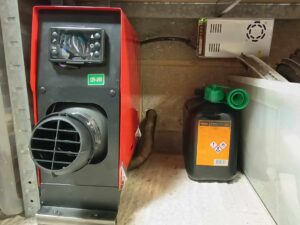
The market has suddenly become flooded with CDHs or Chinese Diesel Heaters. And with it the rise of big internet groups with experts, so-called experts and people who don’t have a clue but feel they need to comment because they read something in a previous post.
A camping friend was talking to me about them. He has one to warm up his home. Now I won’t deny that I was sceptical at this wild gesture. I have a gas-powered Propex in my camper van and with the advent of the 4.5KG Calour gas bottles being discontinued, I am looking at some point to replace it. This however is for something the size of a small van. Not a house. Surely they can’t be that effective?
It’s Getting Hot in Here……
For £109.95 for an All-In-One 8Kw heater with a built-in fuel tank, £15 for a 30A 240v to 12v power converter and another £30 on a few extra exhaust bits, I was £153.95 down. But this is cheap. A new propex in the van will cost over £500! And you still need to buy a gas bottle or carry a 7.3kg bottle. Remember the smaller 4.5kg bottles are now of limited supply.
Fitting up the all-in-one unit was easy. It is the one I recommend for a workshop area. They are available in single units with a heater and tank to be mounted as you will. But these installs look quite messy. Remember to apply caution with these. They are heaters that combust fuel. And various parts like the exhaust, get very hot. If you’re unsure, get an adult to help you.
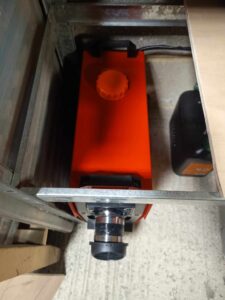
Because of the exhaust, you need to locate a space for it that will be the most convenient for removal, service and more importantly, effective. For me, floor mounted under the shelving was going to be the least intrusive. Without thinking, it also allows for me to sit on the floor in the flow of the heat. Ideal when replacing pushrod seals on a Beetle engine as I soon discovered!
You just need to neatly wire up the power source, drill a hole in the wall for the exhaust and you’re done. While I can inset a urinary catheter down a man’s penis, I’m still not confident in drilling holes through walls, so this job was left to a mate called Dave to do. I highly recommend everyone to get one. After this, you are pretty much ready to go. Grab a 5-litre jerry can of diesel at £7.95 at £1.59 p/l and you are ready to fire up.
………..So Take Off All Your Clothes
And so to the test day. It wasn’t cold. The garage was around 10°. Both the machine and wall thermometer read the same. The difference soon changed. My heater is floor-mounted blowing air into the working space. The thermometer is about 6 feet away and mounted high on the wall. I thought this would give a fair assessment of the ambient temperature around my working area.
Set to max, within an hour, it had climbed to 13.4° on the wall and 18° on the unit. After 5 hours the garage was at a clothes stripping 19°.
Brrr Day Had Arrived
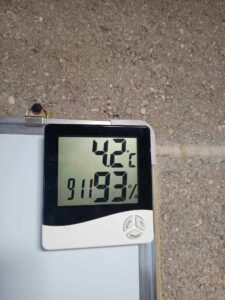
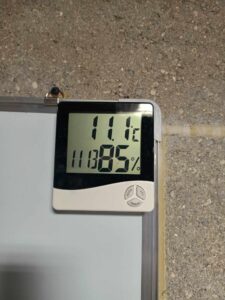
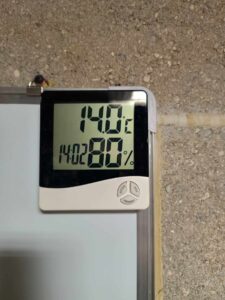
With outside temperatures at 6° and a workshop at 4.2°, now was a good time to test. After 3 hours with the heater on full, the workshop temperature climbed to 12.6°. Now I must add that outside temperature had also started to rise to a max of 9°.
With this in mind and being a bit wasteful because I wasn’t actually working in the garage, it was decided not to max out the heater any more. It had proved what it could do. But how about maintaining a temperature?
On the day I ran it on full, it drank around 3 1/2 litres or £5.57 worth of diesel. These units come with 2 running settings. Thermostatically controlled or Hz (displayed as P 1 to 10. The Hz setting for the speed the machine runs and burns. The higher it runs, the more it consumes. It was set to P05, around halfway and then we waited another hour.
There was a gain but not as much over the initial start where it was colder. Over that hour it raised by a degree. I was happy with that. Likewise, I was also happy with the far corner of the garage behind the van being 13.1° while the work area had raised to 14°.
Looking at the consumption, it drank less than half a tank. Around £3.50 in diesel. With this calculation over my previous space heater, it would have paid for itself and the gas used by the space heater in 15 days.
Could it warm up a house? After this test, I can’t see why it couldn’t warm up a well-insulated home. Perhaps not 2 floors. I can’t deny that I wasn’t impressed. And my home is better insulated than my garage. For now at least! Just don’t mount it like in the advert.
Conclusion
For what doesn’t cost a lot to buy, the all-in-one has proved itself well. Where I once would have just stayed on the sofa under a blanket, I’ve been able to go out and crack on with both the Beetle and Bus.
These units are not without their faults. A friend who bought one after I did have a few niggles that seemed to go away. His thoughts and mine are that they are so cheap if they do fail, just buy another.
WTF! Who knew?
It would appear that there is a caveat. I also recommend you read up about diesel bugs. It is an actual thing!

